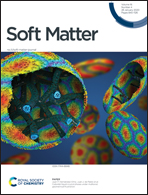Chiral and achiral mechanisms of self-limiting assembly of twisted bundles
Abstract
A generalized theory of the self-limiting assembly of twisted bundles of filaments and columns is presented. Bundles and fibers form in a broad variety of supramolecular systems, from biological to synthetic materials. A widely-invoked mechanism to explain their finite diameter relies on chirality transfer from the molecular constituents to collective twist of the assembly, the effect of which frustrates the lateral assembly and can select equilibrium, finite diameters of bundles. In this article, the thermodynamics of twisted-bundle assembly is analyzed to understand if chirality transfer is necessary for self-limitation, or instead, if spontaneously-twisting, achiral bundles also exhibit self-limited assembly. A generalized description is invoked for the elastic costs imposed by twist for bundles of various states of intra-bundle order from nematic to crystalline, as well as a generic mechanism for generating twist, classified both by chirality but also the twist susceptibility of inter-filament alignment. The theory provides a comprehensive set of predictions for the equilibrium twist and size of bundles as a function of surface energy as well as chirality, twist susceptibility, and elasticity of bundles. Moreover, it shows that while spontaneous twist can lead to self-limitation, assembly of twisted achiral bundles can be distinguished qualitatively in terms of their range of equilibrium sizes and thermodynamic stability relative to bulk (untwisted) states.



 Please wait while we load your content...
Please wait while we load your content...
